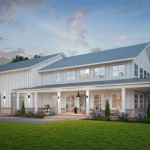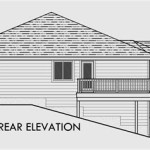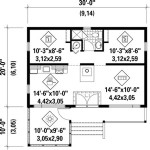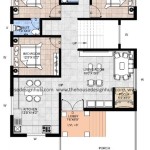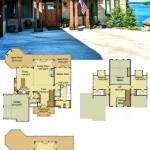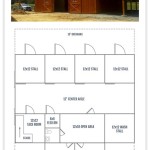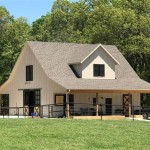House Plans For 2 Bedroom 1 Bath
House plans for a two-bedroom, one-bath dwelling represent a popular and practical choice for a variety of prospective homeowners. These designs cater to individuals, couples, small families, and even empty-nesters seeking a comfortable and efficient living space. The appeal lies in the balance of affordability, manageability, and functionality. This article will explore the diverse options available in two-bedroom, one-bath house plans, highlighting key considerations and design trends.
The versatility of a two-bedroom, one-bath house plan is significant. It provides ample space for a single person or a couple while still offering room for a guest bedroom or a home office. For small families, the two bedrooms can accommodate children or provide separate sleeping areas. The single bathroom, while potentially requiring careful planning, can be efficiently designed to meet the needs of the occupants.
Furthermore, these house plans are often more budget-friendly than larger designs, making them accessible to a wider range of buyers. Maintenance and upkeep are also generally less demanding and costly. The smaller footprint can translate into lower utility bills and reduced landscaping requirements.
Maximizing Space and Functionality
One of the primary considerations when selecting a two-bedroom, one-bath house plan is the efficient use of space. Given the limited square footage compared to larger homes, careful planning is crucial to ensure that the living areas feel comfortable and functional. This involves several key strategies.
Open-concept living areas are frequently employed to create a sense of spaciousness. Combining the living room, dining area, and kitchen into a single, flowing space eliminates walls and visual barriers, making the home feel larger than it actually is. Strategic furniture placement can then define distinct zones within the open area.
The bathroom design is also critical. Optimizing the layout to maximize counter space and storage is essential. Features such as wall-mounted sinks and toilets can free up floor space, while built-in shelving and medicine cabinets provide ample storage for toiletries and other bathroom essentials. Showers can also be designed to provide more functional space than a traditional bathtub/shower combination.
Incorporating natural light is another vital aspect of maximizing space and functionality. Large windows and skylights can brighten the interior and create a more inviting atmosphere. Positioning windows strategically can capture sunlight throughout the day, reducing the need for artificial lighting and enhancing the overall ambiance.
Storage solutions are paramount in a smaller home. Built-in storage, such as shelves, cabinets, and drawers, can help keep clutter to a minimum. Utilizing vertical space by installing tall cabinets or shelving units is an effective way to maximize storage capacity. Additionally, considering storage options in unexpected places, such as under stairs or in attic spaces, can add valuable storage space without sacrificing living area.
Multi-functional furniture can also contribute to efficient space utilization. Sofa beds, ottomans with storage, and tables with folding leaves can serve multiple purposes, adapting to different needs and situations. This type of furniture is particularly useful in smaller homes where space is at a premium.
Closet design is crucial. Utilizing custom closet organizers to optimize the space for hanging clothes, shelves, and drawers is key. Adjustable shelves and rods can make the closet space more versatile and adaptable to different storage needs. Consider adding built-in lighting inside the closet to improve visibility.
Outdoor living spaces can also effectively extend the usable living area. A patio, deck, or porch can provide a comfortable area for relaxing, entertaining, or dining outdoors, effectively expanding the living space during warmer months. Careful planning of the outdoor space, including furniture selection and landscaping, can create a seamless transition from the interior to the exterior.
Architectural Styles and Design Elements
Two-bedroom, one-bath house plans are available in a wide range of architectural styles, catering to diverse aesthetic preferences. From traditional to contemporary, there is a design to suit virtually every taste. Understanding the characteristics of different architectural styles can help prospective homeowners make an informed decision.
Traditional styles, such as Craftsman, Ranch, and Colonial, often feature classic details and timeless appeal. Craftsman homes are characterized by their low-pitched roofs, wide eaves, and exposed rafters. Ranch homes typically have a single-story layout and an open floor plan. Colonial homes often feature symmetrical facades and traditional detailing.
Contemporary styles, such as Modern and Minimalist, emphasize clean lines, simple forms, and a focus on functionality. Modern homes often incorporate large windows, open floor plans, and natural materials. Minimalist homes are characterized by their simplicity, lack of ornamentation, and focus on essential elements.
Other popular architectural styles include Farmhouse, which combines rustic charm with modern amenities, and Cottage, which features cozy spaces and charming details. The choice of architectural style will influence the overall look and feel of the home, as well as the materials and finishes used in construction.
Exterior design elements also play a significant role in the overall aesthetic of the home. The choice of siding material, roof style, window design, and landscaping can all contribute to the curb appeal and character of the house. Selecting materials that are durable, low-maintenance, and visually appealing is essential for creating a home that is both functional and attractive.
Interior design elements are equally important in creating a comfortable and stylish living space. The choice of flooring, paint colors, lighting fixtures, and furniture can all contribute to the overall ambiance of the home. Selecting a cohesive color palette and incorporating textures and patterns can create a visually appealing and inviting interior.
Smart home technology can also be integrated into the design to enhance functionality and convenience. Features such as smart thermostats, lighting controls, and security systems can improve energy efficiency, security, and overall comfort. Integrating these technologies during the design phase can ensure that they are seamlessly integrated into the home's infrastructure.
Consider incorporating sustainable design elements to reduce the environmental impact of the home. Energy-efficient windows, insulation, and appliances can help minimize energy consumption. Water-saving fixtures, such as low-flow toilets and showerheads, can conserve water. Using recycled or renewable building materials can also contribute to a more sustainable home.
Cost Considerations and Budgeting
Budgeting is a critical aspect of selecting a two-bedroom, one-bath house plan. The cost of building or purchasing a home can vary significantly depending on factors such as location, materials, labor, and design complexity. Understanding the various cost components is essential for establishing a realistic budget and avoiding unexpected expenses.
The cost of land is a significant factor, particularly in urban areas or desirable locations. Researching land prices in the desired area is essential for determining the overall affordability of the project. Consider factors such as zoning regulations, accessibility, and proximity to amenities when evaluating land options.
Construction costs can also vary widely depending on the materials used, the complexity of the design, and the availability of skilled labor. Obtaining multiple bids from reputable contractors is essential for comparing prices and ensuring that the project is completed within budget. Be sure to carefully review the bids and understand the scope of work included.
Permitting and inspection fees can also add to the overall cost of the project. Researching the local building codes and regulations is essential for ensuring that the project complies with all applicable requirements. Obtaining the necessary permits and inspections can help avoid costly delays and penalties.
Interior finishes, such as flooring, countertops, cabinets, and appliances, can also impact the overall cost of the project. Selecting materials that are durable, functional, and aesthetically pleasing is essential for creating a comfortable and stylish living space. Consider balancing cost with quality when making these selections.
Landscaping and exterior features can also add to the overall cost of the project. Consider the cost of landscaping materials, irrigation systems, and outdoor lighting when establishing the budget. Plan the landscaping to complement the architecture of the home and create an inviting outdoor space.
Contingency funds are essential for covering unexpected expenses or unforeseen problems that may arise during the construction process. A contingency fund of at least 10% of the total project cost is recommended to provide a buffer for unexpected expenses.
Consider financing options, such as mortgages or construction loans, to help cover the cost of the project. Research different financing options and compare interest rates and terms to find the best option for the specific financial situation.
By carefully considering all of these cost factors and establishing a realistic budget, prospective homeowners can make informed decisions and ensure that the project is completed within their financial means. Thorough planning and attention to detail can help minimize unexpected expenses and create a comfortable and affordable home.

Hpm Home Plans Plan 001 3304 One Bedroom House Small Floor 1

Tiny Ranch Home 2 Bedroom 1 Bath 800 Square Feet

Pin On House Plans

2 Bedroom 1 Bathroom Bed Apartment Briarwood Village

2 Bedrm 864 Sq Ft Bungalow House Plan 123 1085

22x32 House 2 Bedroom 1 Bath 704 Sq Ft Floor Plan

2 Bedroom 992 Sq Ft Tiny Small House Plan With Porch 123 1042

12 Simple 2 Bedroom House Plans With Garages Houseplans Blog Com

Floor Plans Aflfpw17415 1 Story Cottage Home With 2 Bedrooms Bathroom And 856 Total Square Feet Style House

2 Bedroom Tiny House Plans Blog Eplans Com


